This page contains the detailed and easy notes for GCSE OCR 21st Century Chemistry Chemicals of the natural environment for revision and understanding Chemicals of the natural environment.
Banner 1
GCSE OCR 21st Century Chemistry Chemicals of the natural environment Complete Revision Summary
Chemicals of the natural environment
- Ionic Bonding
- Covalent Bonding
- Metallic Bonding 6
- State of Matter
- Ionic compounds
- Covalent Compounds
- Diamond and Graphite
- Nanoparticles
- Graphene and Fullerene
- Hydrocarbons and Crude Oil
- Alkanes
- Fractional Distillation
- Properties of Hydrocarbons
- Cracking
- Alkenes
- Reaction of Alkenes
- Alcohols
- Carboxylic Acid
- Addition Polymerization
- Condensation Polymerization
- Amino Acids
- DNA
BONDING
Atoms bond to gain full outer shell or noble gas electronic configuration
Ionic Bonding
- transfer of electron between metals and non metals
- between metal and non metals
Covalent Bonding
- sharing of electron between non metals
- between non metals
Metallic Bonding
- Electrostatic force of attraction between fixed positive ions and delocalised electrons.
- between Metals
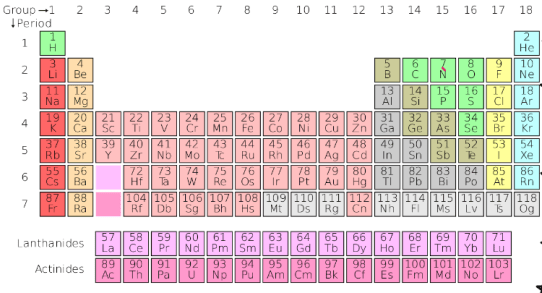
Carbon dioxide (CO2) – Covalent
Ammonia (NH3) – Covalent
Nitrogen (N2) – Covalent
Water (H2O) – Covalent
Sodium chloride -Ionic Bonding
Calcium fluoride— Ionic Bonding
IONIC BONDING: Metals and Non Metals
- It is between a metal and a non metal
- Metal loses an electron and become positively charged.
- Non- Metal gains an electron and becomes negatively charged.
- There is a strong electrostatic force of attraction between opposite charged ions resulting in ionic bonding.
Dot and Cross Diagram
- Write the symbols
- Write electronic configuration
- show outer electrons
- show transfer
- show charges
Example – Aluminium Fluoride
Al = 2,8,3
F = 2,7
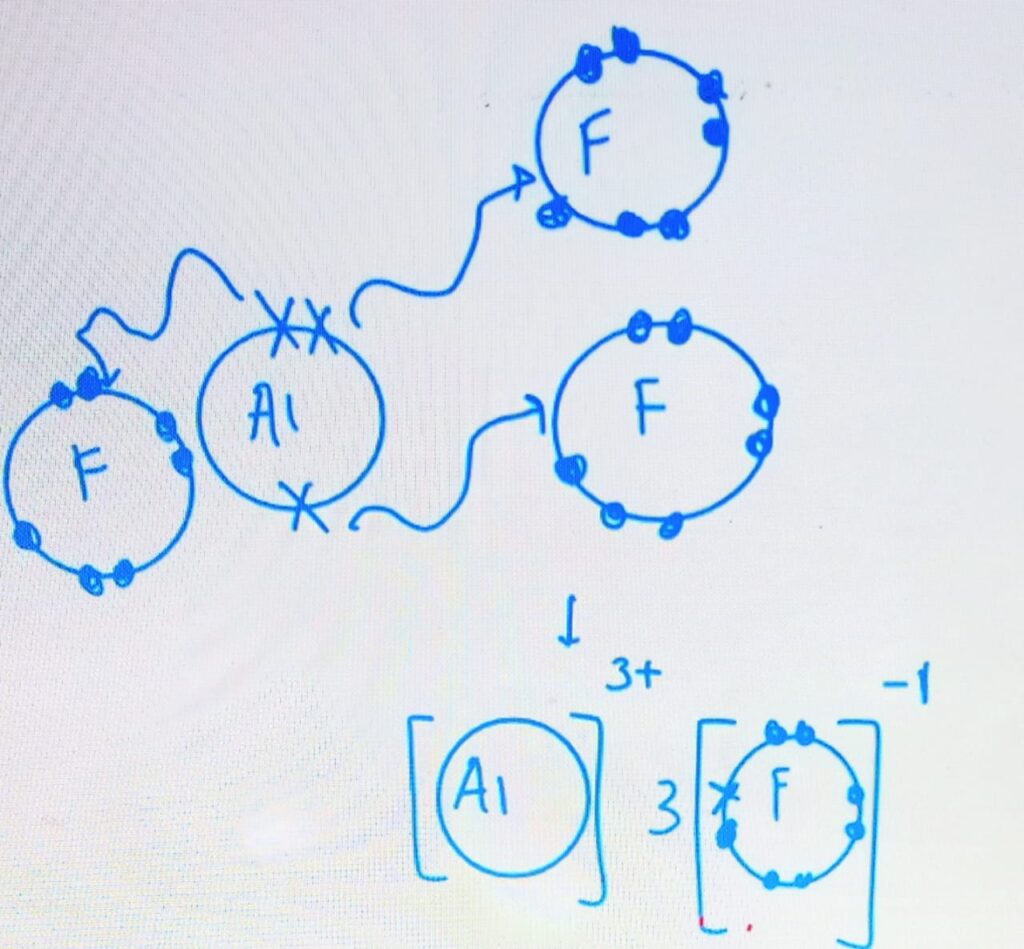 Example – Magnesium chloride
Mg = 2,8,2
Cl = 2,8,7
Example – Magnesium chloride
Mg = 2,8,2
Cl = 2,8,7
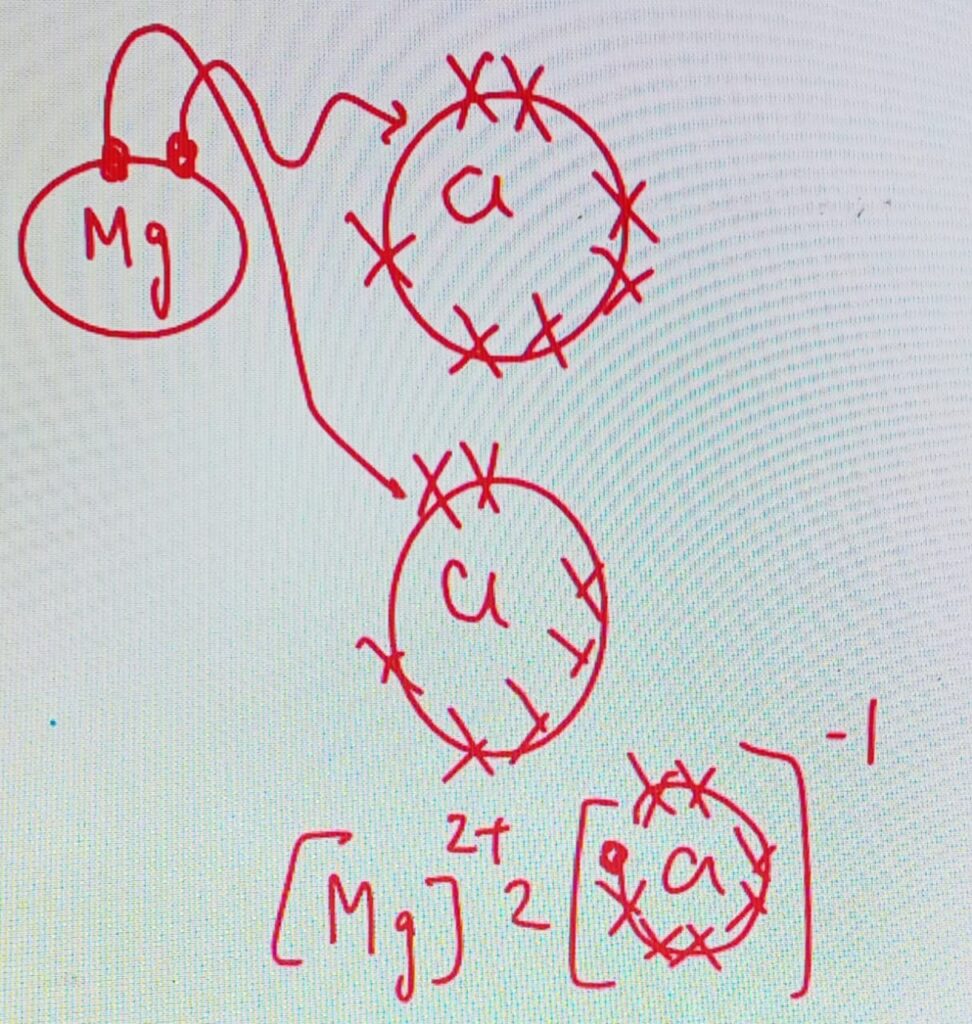 PROPERTIES OF IONIC COMPOUNDS
Ionic Compound Properties
PROPERTIES OF IONIC COMPOUNDS
Ionic Compound Properties
- Brittle solids with definite crystal shapes
In Ionic compounds, there is a strong electrostatic force of attraction between the opposite charged ions. This results in the formation of giant ionic lattice.
- Good insulators in solid form, but become good conductors in liquid or dissolved form.
In the solid form, the ions are not free to move as they are held together by strong electrostatic force of attraction. In molten or when they are dissolved in water the ions are free to move and conduct electricity.
- High melting and boiling point compared to molecular compounds
In Ionic compounds, there is a strong electrostatic force of attraction between the opposite charged ions. This results in the formation of giant ionic lattice. Large amount of energy is required to overcome the strong electrostatic force of attraction. Therefore, ionic compounds have high melting and boiling point.
Greater the charge of an ionic lattice, stronger is the electrostatic force of attraction. Greater the melting and bp.
For éx – Aluminium chloride > Magnesium chloride > sodium chloride
FORMULAE OF IONIC COMPOUNDS
- Write the Symbols
- Write the charges
- (Upto group the charge is same as the group number. After group 4 it is group number -8)
- Criss Cross
- a) Sodium Oxide = Na2O
- b) Magnesium Nitride = Mg3N2
- c) Calcium Oxide = CaO
- d) Sodium Sulphide = N2S
- e) Sodium Chloride = NaCl
- f) Magnesium chloride = MgCl2
- g) Aluminium Chloride = ACl3
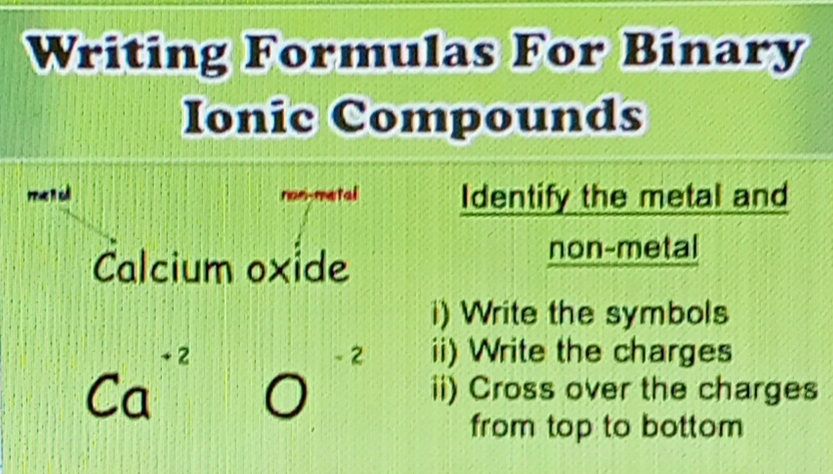
 FORMULAE OF COMPLEX IONS
FORMULAE OF COMPLEX IONS
| a) Magnesium Hydroxide |
Al2(SO4)3 |
| b) Aluminium Sulphate |
Al2(SO4)3 |
| c) Calcium Phosphate |
Ca3(PO4)2 |
| d) Magnesium nitrate |
Mg(NO3)2 |
| e) Calcium Carbonate |
CaCO3 |
| f) Sodium Phosphate |
Na3PO4 |
| Positive |
Negative |
| Ammonium = NH4+ |
Carbonate = CO32- |
|
Sulphate = SO42- |
|
Nitrate = NO3– |
|
Phosphate = PO43- |
|
Hydroxide = OH– |
[download_after_email id=”10047″]
COVALENT BONDING
- It is between two non metals
- It involves the sharing of electrons between two non metals.
- More than one electron pair can also be shared resulting in the formation of single double and triple bonds.
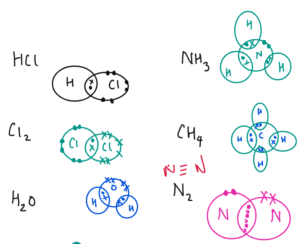
Properties of Covalent Compounds
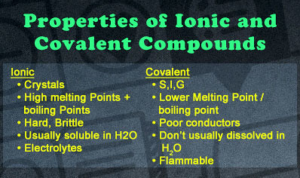 Simple Molecule
Simple Molecule
- Eg – O2, CH4
- They have weak intermolecular forces in them so have a lower melting and a boiling points
- The intermolecular forces increases with increase in size as the surface area between the molecules increases.
- Therefore, polymers which have covalent bonding between them have high melting and boiling point due to increase in chain length.
Giant Covalent
- Diamond
- Graphite
- Silicon Dioxide
GIANT COVALENT STRUCTURES
Substances which have huge network of atoms joined together by covalent bonds form giant covalent structures.
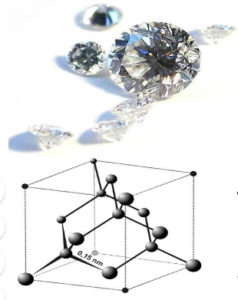
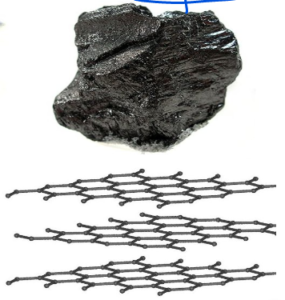
| DIAMOND |
GRAPHITE |
| It is hard. |
It is soft and greasy. |
| It is an insulator |
It is a conductor |
| It has a high density. |
It has a lower density than diamond. |
| Each carbon atom is covalently bonded to four other carbon atoms giving it a strong rigid structure |
Carbon atoms are bonded in the form of layer in the form of hexagons. No covalent bonding between the layers so they can slide past. Each carbon atom is bonded with three other carbon leaving the fourth electron has delocalized |
| No delocalised electrons present |
It has delocalised electrons |
| Used in cutting or jewellery |
It is used in pencil leads. |
PROPERTIES OF GRAPHITE
Q1 Why graphite is soft and slippery?
Banner 5
In graphite, Carbon atoms are bonded in the form of layers in the form of hexagons. No covalent bonding between the layers so they can slide past each other. The layers have only weak intermolecular forces between them. By applying a little pressure then layers can easily slide past each other making Graphite soft and slippery.
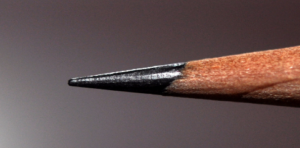 Q2 Why graphite conduct electricity ?
Q2 Why graphite conduct electricity ?
In graphite, Carbon atoms are bonded in the form of layer in the form of hexagons. No covalent bonding between the layers so they can slide past. Each carbon atom is bonded with three other carbon leaving the fourth electron has delocalized. These delocalized electrons are mobiles electrons which can move and conduct electricity.
FULLERENE AND GRAPHENE
Fullerene: Hollow shaped molecule having hexagonal rings like a bucky ball.
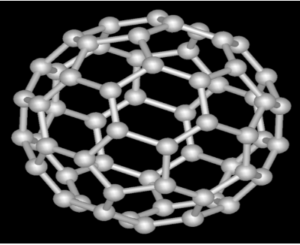
- Also known as bucky ball or buckminsterfullerene.
- Carbon can be in the form of pentagon or hexagon rings
- Used as catalyst, drug delivery and treating cancer.
- Graphene: Layer of interlocking hexagonal rings like single sheet of graphite.
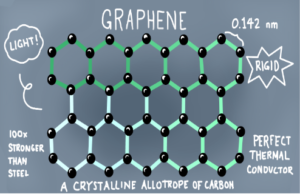
- It is a better conductor than graphite, light and have low density.
- Used in making computer chips and flexible electronic displays.
Baneer 6
CARBON NANOTUBES
- Cylinderical fullerene with the length greater than the diameter.
- High tensile strength – Used in making reinforced composite materials
- High electronic conductivity – used in electronic industry
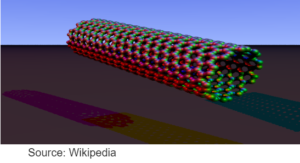
METALLIC BONDING
- It is between two metals.
- There are fixed positive ions present in the sea of delocalised electrons.
- There is strong electrostatic force of attraction between fixed positive ions and delocalized electrons resulting in metallic bonding.
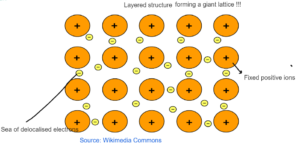
Banner 8
Properties of Metals
Metals are malleable
- Malleable means that the metals can be hammered into any shape.
- Metals have layered structure and layers can slide past each other by hammering giving metals different shapes.
Metals are ductile
- Ductile means that the metals can be drawn into thin wires.
- Metals have layered structure and layers can slide past each other by hammering giving metals a wire shape.
Metallic Bonding
- Atoms in a metal are arranged in a regular manner and vibrate about fixed positions.
- The outermost electrons move freely, forming a ‘sea of electrons’ enveloping the positive metal ions.
Metals are good conductors of electricity
- Metals have delocalised electrons.
- They are mobile and conduct electricity.
- These mobile electrons or delocalised electrons conduct heat and electricity.
Metals have high melting and boiling points
- There is strong electrostatic force of attraction between fixed positive ions and delocalized electrons.
- Large amount of energy is required to overcome strong electrostatic force of attraction.
Banner 9
ALLOYS
- Alloys are the mixture of metals with another metal or a non metal which make the metal stronger.
- In metals the particles are arrranged in layers. There is a regular arrangement of fixed positive ions which can slide past each by applying pressure.
- In alloys there is a mixture of metals with another metal or a non metals. Another metal being different in shape and size distort the regular arrangement of the metal lattice.
- As a result the layers of the metal can no longer slide past each other making it strong
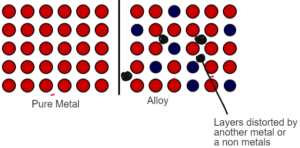
Example: Steel is the alloy of iron which is more strong and resistant to corrossion.
NANOPARTICLES
Nanoparticles are the particles that deals with the paricles of size 1 to 100 nm.
 KIL- Killing
MET – Metal
MIL -Milo
MIC – Mickey
NAN – Nano
PIC – Pictures
Convert 10 nm to
KIL- Killing
MET – Metal
MIL -Milo
MIC – Mickey
NAN – Nano
PIC – Pictures
Convert 10 nm to
- Metre = 10/109m = 10-8m
- Micrometer = 10/106m = 10-5m
SURFACE AREA TO VOLUME RATIO
As the size decreases the surface area to volume ratio Increases.
Therefore Nano particles being very small in size have large surface area to volume ratio making them very useful in Science and Medicine.

Surface area = 6 x side x side m
2
= 6 x 1000 x 1000
= 6 10
6 m
2
Volume = side x side x side
= 10
9m
3
SA: Volume = 6 x 10
6/10
9 = 6 x 10
3 m

Surface area = 6 x side x side m
2
= 6 x 1000 x 1000
= 6 10
4 m
2
Volume = side x side x side
= 10
6m
3
SA: Volume = 6 x 10
2 m
Banner 10
APPLICATIONS OF NANOPARTICLES
MEDICINES
- To kill cancer and tuomour cells
- For drug delievery
CATALYST
- They have large surface area to volume ratio.
- Used in small quantities so highly effective
COSMETICS
- Used in Sunscreen to block sunlight
HOUSEHOLD
- Self cleaning window panes
- Nano particles breaks dirty in the presence of sunshine which is washed away by water while raining.
RISKS OF NANOPARTICLES
- Due to small size can cause difficulty in breathing
- They can accumulate in the envrionment and cause air pollution
- Due to their large surface area a small spark can result in violent explosion making them risky to use.
- They are toxic and cause breathing and respiratory problems.
- Due to their small size they can also cause water pollution and risk the aquation life.
STATES OF MATTER
| SOLIDS |
LIQUIDS |
GASES |
| Particles are close to each other. |
Particles are slightly closer to each other. |
Particles are far apart. |
| Have fixed shape |
Do not have fixed shape |
Do not have fixed shape |
| Strong forces between the particles |
Weak forces between the particles |
Very weak forces between the particles. |
| Have definite volume |
Have fixed volume |
Do not have fixed volume |
| cannot be compressed |
Can be compressed |
Highly compressible |
| Cannot flow |
Can flow |
Can flow |
Banner 11
KEY TERMS !!!!
Ions – charged atoms with unequal number of protons and electrons
Ionic Bonding — bond formed between a metal and a non metal which involves complete transfer of electrons from metal to a non metal
Dot and Cross — diagram that show transfer of electron in an ionic bond or sharing of electrons in a covalent bond.
Covalent Bonding— bonding between two non metals which involves sharing of electrons.
Metallic Bonding— bonding in metals which involves strong electrostatic forces of attraction between fixed positive ions and delocalised electrons.
Intermolecular Forces — The forces between the molecules which determines the melting or a boiling point.
Giant Covalent Molecules — Covalently bonded molecules which forms large giant structure
Polymers – Molecules which are made up of many repeating units
Delocalised electrons — Mobile electrons that are free to move as they are not associated with a bond or an atom.
Fullerene— Allotrope of carbon which forms a cage like structure like bucky ball.
Graphene— Allotrope of carbon which is equivalent to single layer of graphite
Alloys— Mixture of metals with another metal or a non metal.
Nanoparticles- particles which are of the size of 1 nm to 100 nm_
Nanoscience—lt is the branch of science that deals with nanoparticles
State Of Matter-Different forms that a matter can take They are solids, liquids and gas
Solids — States of matter with fixed shape and volume.
Liquids— States of matter without fixed shape but fixed volume.
Gases— States of matter with fixed shape and volume.
TEST YOURSELF
Q1 Name the type of bonding in the following compounds :
- a) Sodium Chloride – Ionic
- b) Magnesium – Metallic
- c) Nitrogen – Covalent
- d) Carbon Dioxide – Covalent
- e) Water – Covalent
- f) Ammonia – Covalent
Q2 Draw dot and cross diagram to represent bonding in the following
- a) Sodium chloride
- b) Water
- c) Magnesium
Q3 Differentiate Between Diamond and Graphite
| DIAMOND |
GRAPHITE |
| It is hard. |
It is soft and greasy. |
| It is an insulator |
It is a conductor |
| It has a high density. |
It has a lower density than diamond. |
| Each carbon atom is covalently bonded to four other carbon atoms giving it a strong rigid structure |
Carbon atoms are bonded in the form of layer in the form of hexagons. No covalent bonding between the layers so they can slide past. Each carbon atom is bonded with three other carbon leaving the fourth electron has delocalized |
| No delocalised electrons present |
It has delocalised electrons |
| Used in cutting or jewellery |
It is used in pencil leads. |
Q4 Why Ionic compounds do not conduct electricity in solids ?
In solids, the ions are held together by strong electrostatic force of attraction in the giant ionic lattice. In molten state the ions are free to move therefore conduct electricity
Q5 Why Alloys are stronger than metals
Alloys are the mixture of metals which distors the regular arrangement of metal as a result of which layers are not able to slide past each other making alloys stronger than metals.
Q6 Why alumunium has a stronger melting point than sodium
Aluminium has a greater charge. Due to greater charge of aluminium there is a stronger electrostatic forces of attraction between fixed positive ions and delocalised elecctrons. As a result aluminium has a greater melting point than sodium.
Q7 What are nanoparticles? Write the properties and applications of nanoparticles
Nanoparticles are the particles between the size of 1 to 100 nm_ Due to smaller size they have large surface area to volume ratio making them highly useful in medicine, catalysts, cosmetics and electronic industry.
CRUDE OIL
- It is a black thick liquid which takes millions of years to form.
- It is the mixture of hydrocarbon.
- Hydrocarbon are the compounds made up of carbon and hydrogen only.
- The components of the crude oil are important and the crude oil is separated by the process of fractional distillation.
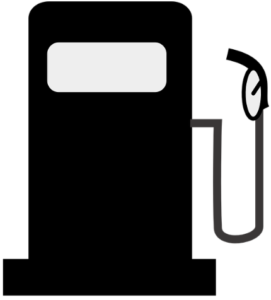
HYDROCARBON PROPERTIES
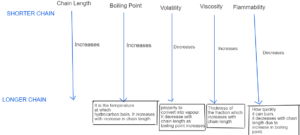
Banner 3
FRACTIONAL DISTILLATION OF CRUDE OIL
- Separating the mixtures on the basis of boiling points.
- It is separated in fractionating column with different substances of similar boiling points
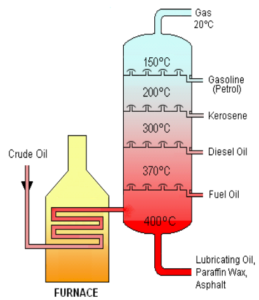
| LIQUIFIED GAS |
FUEL |
| GASOLINE/PETROL |
CAR FUEL |
| KEROSENE |
AIRCRAFT FUEL |
| DIESEL OIL |
FUEL IN DIESEL ENGINES |
| RESIDUE |
MAKING ROADS |
L – Look
G – Great
K – Kid
D – Doing
R – Roll
CRACKING –Thermal decomposition of longer chain hydrocarbon into a shorter chain alkane and alkenes
Thermal Cracking Catalytic Cracking
It is done at a very high temperature It is done using a catalyst
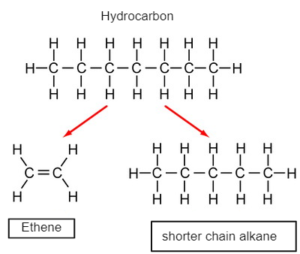
Banner 3
WHY CRACKING
- Shorter chain alkanes are more in demand as they are more efficient fuel which fractional distillation alone cannot meet.
- Alkenes are required for polymerization and synthesize other hydrocarbons which fractional distillation cannot meet.
ALKANES – Saturated Hydrocarbon
Carbon-carbon single bond made up of carbon and hydrogen
General Formulae CnH2n+2
Methane – CH4
Ethane – C2H6
Propane – C3H8
Butane – C4H10
Pentane – C5H12
Homologous Series – Members of the same family have similar functional group similar chemical properties and general formulae but different physical property and each members differs from successive by CH2.
COMBUSTION
COMPLETE
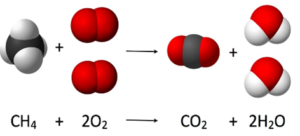 |
INCOMPLETE
 |
|
|
| FUEL IS COMPLETELY BURNED |
FUEL IS PARTIALLY BURNED DUE TO LIMITED SUPPLY OF OXYGEN
|
| PRODUCES CARBON DIOXIDE AND WATER |
PRODUCES CARBON MONOXIDE AND WATER
|
| IT IS NOT TOXIC |
CARBON MONOXIDE IS TOXIC AS IT DECREASES. THE OXYGEN CARRYING CAPACITY OF RED BLOOD CELLS
|
PRODUCTS OF COMBUSTION
Carbon Dioxide Test
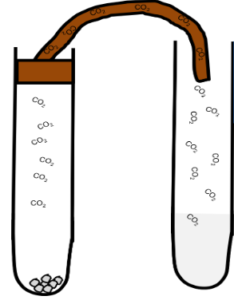
Limewater Test Carbon Dioxide will turn limewater milky
Water Test
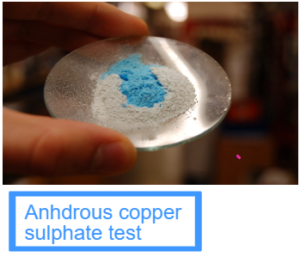

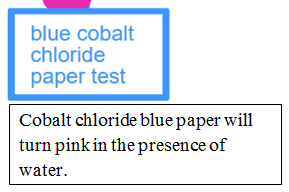
Banner 4
FUNCTIONAL GROUPS
Groups of atoms that give special properties and reactions to the organic molecule
| |
Functional Groups |
Examples |
Formation |
| ALKENES |
= |
Ethene, propene, butene, pentene |
Cracking of crude oil |
| ALCOHOLS |
-OH |
methanol, ethanol, propanol, butanol, pentanol |
Reaction of alkene with water |
| CARBOXYLIC ACID |
 |
methanoic acid, ethanoic acid, propanoic acid, butanoic acid. |
Oxidation of alcohols |
| ESTERS |
 |
methyl ethanoate, ethyl ethanoate |
Reaction of alcohols and carboxylic acid |
ALKENES
Unsaturated Hydrocarbon
- Compounds which have carbon-carbon double bond
- Compounds made up of carbon and hydrogen only
GENERAL FORMAULE CnH2n
Useful to make polymers, alkanes, alcohols
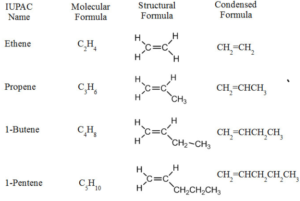
MANUFACTURE OF ETHANOL
| |
FERMENTATION |
HYDRATION OF ETHENE |
| REACTION |
Glucose Ethanol + carbon dioxide
C6H12O6 2C2H5OH + 2CO2 |
Ethene + Steam Ethanol |
| REACTION CONDITIONS |
Gentle temperature and pressure. Anaerobic conditions |
Nickel catalyst and high temperature and pressure |
| ADVANTAGES |
Uses renewable resources like sugarcane. Less dependent on fossil fuels and due to less energy requirements do not harm the environment. |
It is a continuous process. It is rapid more efficient and have 100% atom economy. Produces more pure ethanol |
| DISADVANTAGES |
It is a batch process. The ethanol has to be distilled from time to time as high concentration will kill the yeast. The reaction is slow and produces impure ethanol. Also the atom economy is not 100% |
Requires ethene which is dependent on crude oil. Uses non renewable resources. |
Banner 5
REACTIONS OF ALKENES
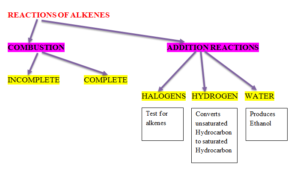
ALCOHOLS – Have functional Group –OH
General Formulae
CnH2n+1 OH
Formed by replacing hydrogen of alkane with OH group
Used as fuel, solvents, spirits
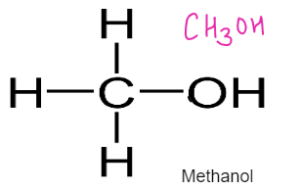
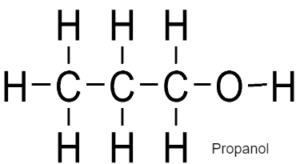

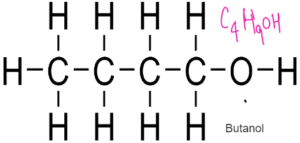
REACTIONS OF ALCOHOLS
COMBUSTION
- It can undergo complete or incomplete combustion. Complete combustion produces carbon dioxide and water.
- Ethanol + Oxygen = Carbon dioxide + water
C2H5OH + O2 CO2 + H2O
- Incomplete combustion produces carbon dioxide and water.
- Ethanol + Oxygen = Carbon monoxide + water
C2H5OH + O2 CO + H2O
OXIDATION
- Alcohols are oxidised to carboxylic acid in the presence of oxidising agent.
- Methanol Methanoic Acid
- Ethanol Ethanoic Acid
- Oxidising agent used is acidified potassium dichromate solution
METAL
Alcohols react with metals to form salt and hydrogen.
2C2H5OH + 2Ca 2C2H5OCa + H2
CARBOXYLIC ACID
Weak Acids
Carboxylic Acids are weak acids as they are partially dissociated in water to release H+ ions.
CH3COOH ⇌ CH3COO– + H+
Metal oxides and Metal hydroxide
Carboxylic Acid reacts with metal oxides and metal hydroxide to form salt and water.
CH3COOH + NaOH CH3COONa + H2O
Metal carbonate
Carboxylic Acid reacts with metal carbonate to form salt, water and carbon dioxide.
CH3COOH + Li2CO3 CH3COOLi + CO2 + H2O




Baneer 6
ESTERS
- Fruity smelling compounds
- Used in the manufacture of perfumes, foods and cosmetics.
CARBOXYLIC ACID + ALCOHOLS ESTERS + WATER
Alkyl alkanoate
Methanoic Acid + Methanol Methyl methanoate + Water

ADDITION POLYMERIZATION
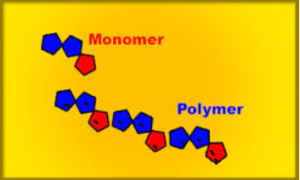
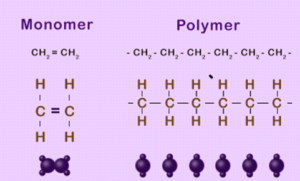
- The individuals unit that polymerizes to form a polymers is known as a monomers. Eg Ethene
- The structure formed by the polymerization of the monomer is a polymers.
Polymers are materials made by linking up smaller repeating chemical units.
Some bend and stretch – rubber and polyester.
Some hard and tough – epoxies and glass.
ADDITION POLYMERS
- a) Formed by addition reaction.
- b) Require only one monomer generally an alkene
- c) Nothing is lost in the reaction.
eg Polyethene, polypropene
CONDENSATION POLYMERS
- a) Requires two monomers
- b) Requires two functional group
- c) Formed by condensation reaction.
- d) A small molecule of water is
- e) Example: Nylon a polyester
NATURAL POLYMERS
- a) They are found naturally
- b) All the complex biomolecules are polymers
| Monomer |
Polymer |
| Glucose |
Starch |
| Proteins |
Amino Acid |
| Nucleotide |
DNA |
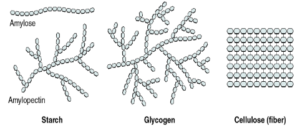
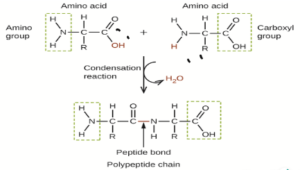
DNA
- a) DNA is polynucleotide
- b) Nucleotide = Phosphate + Sugar + Nitrogenous Bases
- c) There are four bases present in the DNA
- Adenine
- Thymine
- Guanine
- Cytosine
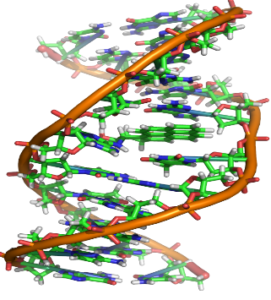
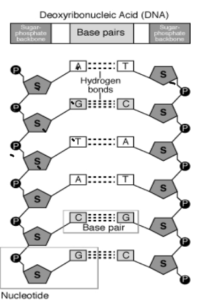
KEY TERMS
Hydrocarbon – Hydrocarbon are the compounds made up of carbon and hydrogen only.
Crude Oil – It is a black thick liquid which takes millions of years to form. It is the mixture of hydrocarbon.
Fractional Distillation – Separating the mixtures on the basis of boiling points.
Alkanes – Saturated Hydrocarbon. Carbon-carbon single bond. Made up of carbon and hydrogen only
Saturated hydrocarbon – Saturated Hydrocarbons have only carbon-carbon single bonds.
Unsaturated hydrocarbon – Unsaturated Hydrocarbons have carbon-carbon double bonds and triple bonds.
General Formula – It applies to families of compounds; provides a way to predict the molecular formula of the molecule, based on the number of carbon atoms it contains.
Viscosity – movement of flow. A fluid with low viscosity flows easily
Flammable – Flammable materials are combustible materials that can easily ignite at room temperature
Complete Combustion – Fuel is completely burned. Produces Carbon dioxide and water.
Incomplete Combustion – Fuel is partially burned due to limited supply of oxygen. Produces Carbon Monoxide and Water.
Cracking – Thermal decomposition of longer chain hydrocarbon into a shorter chain alkane and alkenes
Alkenes – Unsaturated Hydrocarbon. Compounds which have carbon-carbon double bond. Compounds made up of carbon and hydrogen only
Functional Group – Groups of atoms that give special properties and reactions to the organic molecule
Homologous Series – Members of the same family have similar functional group similar chemical properties and general formulae but different physical property and each members differs from successive by CH
2
Alcohols – Have functional Group –OH. The General Formulae of Alcohols is CnH
2n+1 OH. Used as fuel, solvents, spirits
Carboxylic Acid – Carboxylic Acids are weak acids as they are partially dissociated in water to release H+ ions.
Esters – Fruity smelling compounds. Used in the manufacture of perfumes, foods and cosmetics.
Fermentation – Fermentation is a metabolic process that produces chemical changes in organic substrates through the action of enzymes.
Weak Acid – Weak acids are only partially ionized in their solutions.
Monomers – The individuals unit that polymerizes to form a polymers is known as a monomers. Eg Ethene
Polymers – The structure formed by the polymerization of the monomer is a polymers. Polymers are materials made by linking up smaller repeating chemical units.
Some bend and stretch – rubber and polyester.
Some hard and tough – epoxies and glass.
Addition Polymerization – It is the process of repeated addition of monomers with double or triple bonds to form polymers. There is no loss of an atom or a molecule. Ex – PVC, polyethene, Teflon.
Condensation Polymerization – It is a process that involves repeated condensation reactions between two different monomers. There is a loss of a molecule of water, ammonia etc as a by-product. Ex – Nylon, bakelite, silicon.
Monosaccharide – Simplest carbohydrates (single units). They cannot be hydrolyzed into smaller units. Ex – Glucose, fructose.
Polysaccharide – Formed of numerous monosaccharide units. Ex – starch, cellulose
Starch – It is the reserve food material of plant cells. It consists of two components- amylose and amylopectin, both glucose polymers.
Cellulose – Main structural polysaccharide of plants. It is a long, unbranched chain of about 6,000 glucose units with molecular weight between 0.5 to 2.5 million.
Proteins – The proteins are linear unbranched polymers of Amino acids. The proteins are composed of carbon, hydrogen, oxygen, nitrogen, and Sulphur.
DNA – It is a long, double chain of deoxyribonucleotide units. DNA is the genetic material and forms molecular basis of heredity in all organisms.
Banner 12
Disclaimer:
I have tried my level best to cover the maximum of your specification. But this is not the alternative to the textbook. You should cover the specification or the textbook thoroughly. This is the quick revision to help you cover the gist of everything. In case you spot any errors then do let us know and we will rectify it.
References:
BBC Bitesize
Wikipedia
Wikimedia Commons
Image Source:
Wikipedia
Wikimedia
Commons
Flickr
Pixabay
 Carbon dioxide (CO2) – Covalent
Ammonia (NH3) – Covalent
Nitrogen (N2) – Covalent
Water (H2O) – Covalent
Sodium chloride -Ionic Bonding
Calcium fluoride— Ionic Bonding
IONIC BONDING: Metals and Non Metals
Carbon dioxide (CO2) – Covalent
Ammonia (NH3) – Covalent
Nitrogen (N2) – Covalent
Water (H2O) – Covalent
Sodium chloride -Ionic Bonding
Calcium fluoride— Ionic Bonding
IONIC BONDING: Metals and Non Metals
 Example – Magnesium chloride
Mg = 2,8,2
Cl = 2,8,7
Example – Magnesium chloride
Mg = 2,8,2
Cl = 2,8,7
 PROPERTIES OF IONIC COMPOUNDS
Ionic Compound Properties
PROPERTIES OF IONIC COMPOUNDS
Ionic Compound Properties

 FORMULAE OF COMPLEX IONS
FORMULAE OF COMPLEX IONS

 Simple Molecule
Simple Molecule


 Q2 Why graphite conduct electricity ?
In graphite, Carbon atoms are bonded in the form of layer in the form of hexagons. No covalent bonding between the layers so they can slide past. Each carbon atom is bonded with three other carbon leaving the fourth electron has delocalized. These delocalized electrons are mobiles electrons which can move and conduct electricity.
Q2 Why graphite conduct electricity ?
In graphite, Carbon atoms are bonded in the form of layer in the form of hexagons. No covalent bonding between the layers so they can slide past. Each carbon atom is bonded with three other carbon leaving the fourth electron has delocalized. These delocalized electrons are mobiles electrons which can move and conduct electricity.



 Banner 8
Banner 8
 Example: Steel is the alloy of iron which is more strong and resistant to corrossion.
Example: Steel is the alloy of iron which is more strong and resistant to corrossion.
 KIL- Killing
MET – Metal
MIL -Milo
MIC – Mickey
NAN – Nano
PIC – Pictures
Convert 10 nm to
KIL- Killing
MET – Metal
MIL -Milo
MIC – Mickey
NAN – Nano
PIC – Pictures
Convert 10 nm to
 Surface area = 6 x side x side m2
= 6 x 1000 x 1000
= 6 106 m2
Volume = side x side x side
= 109m3
SA: Volume = 6 x 106/109 = 6 x 103 m
Surface area = 6 x side x side m2
= 6 x 1000 x 1000
= 6 106 m2
Volume = side x side x side
= 109m3
SA: Volume = 6 x 106/109 = 6 x 103 m
 Surface area = 6 x side x side m2
= 6 x 1000 x 1000
= 6 104 m2
Volume = side x side x side
= 106m3
SA: Volume = 6 x 102 m
Banner 10
Surface area = 6 x side x side m2
= 6 x 1000 x 1000
= 6 104 m2
Volume = side x side x side
= 106m3
SA: Volume = 6 x 102 m
Banner 10

 Banner 3
Banner 3

 Banner 3
Banner 3



 Banner 4
FUNCTIONAL GROUPS
Groups of atoms that give special properties and reactions to the organic molecule
Banner 4
FUNCTIONAL GROUPS
Groups of atoms that give special properties and reactions to the organic molecule









 Baneer 6
Baneer 6








 Example – Magnesium chloride
Mg = 2,8,2
Cl = 2,8,7
Example – Magnesium chloride
Mg = 2,8,2
Cl = 2,8,7
 PROPERTIES OF IONIC COMPOUNDS
Ionic Compound Properties
PROPERTIES OF IONIC COMPOUNDS
Ionic Compound Properties

 FORMULAE OF COMPLEX IONS
FORMULAE OF COMPLEX IONS

 Simple Molecule
Simple Molecule


 Q2 Why graphite conduct electricity ?
In graphite, Carbon atoms are bonded in the form of layer in the form of hexagons. No covalent bonding between the layers so they can slide past. Each carbon atom is bonded with three other carbon leaving the fourth electron has delocalized. These delocalized electrons are mobiles electrons which can move and conduct electricity.
Q2 Why graphite conduct electricity ?
In graphite, Carbon atoms are bonded in the form of layer in the form of hexagons. No covalent bonding between the layers so they can slide past. Each carbon atom is bonded with three other carbon leaving the fourth electron has delocalized. These delocalized electrons are mobiles electrons which can move and conduct electricity.



 Banner 8
Banner 8
 Example: Steel is the alloy of iron which is more strong and resistant to corrossion.
Example: Steel is the alloy of iron which is more strong and resistant to corrossion.
 KIL- Killing
MET – Metal
MIL -Milo
MIC – Mickey
NAN – Nano
PIC – Pictures
Convert 10 nm to
KIL- Killing
MET – Metal
MIL -Milo
MIC – Mickey
NAN – Nano
PIC – Pictures
Convert 10 nm to
 Surface area = 6 x side x side m2
= 6 x 1000 x 1000
= 6 106 m2
Volume = side x side x side
= 109m3
SA: Volume = 6 x 106/109 = 6 x 103 m
Surface area = 6 x side x side m2
= 6 x 1000 x 1000
= 6 106 m2
Volume = side x side x side
= 109m3
SA: Volume = 6 x 106/109 = 6 x 103 m
 Surface area = 6 x side x side m2
= 6 x 1000 x 1000
= 6 104 m2
Volume = side x side x side
= 106m3
SA: Volume = 6 x 102 m
Banner 10
Surface area = 6 x side x side m2
= 6 x 1000 x 1000
= 6 104 m2
Volume = side x side x side
= 106m3
SA: Volume = 6 x 102 m
Banner 10

 Banner 3
Banner 3

 Banner 3
Banner 3





 Banner 4
FUNCTIONAL GROUPS
Groups of atoms that give special properties and reactions to the organic molecule
Banner 4
FUNCTIONAL GROUPS
Groups of atoms that give special properties and reactions to the organic molecule











 Baneer 6
Baneer 6







